You will love this recipe for Mediterranean Pulled Beef. The slow cooking method ensures that the beef is meltingly tender, and as it slowly cooks, the beef absorbs the Mediterranean flavours of garlic, onion, rosemary, oregano and tomatoes. A less expensive cut of meat is transformed into a flavour-filled dish, and as the cooking time is mostly hands-off, dinner time is made easy with this delicious beef recipe. Serve with creamy polenta, crusty bread, over pasta and more.
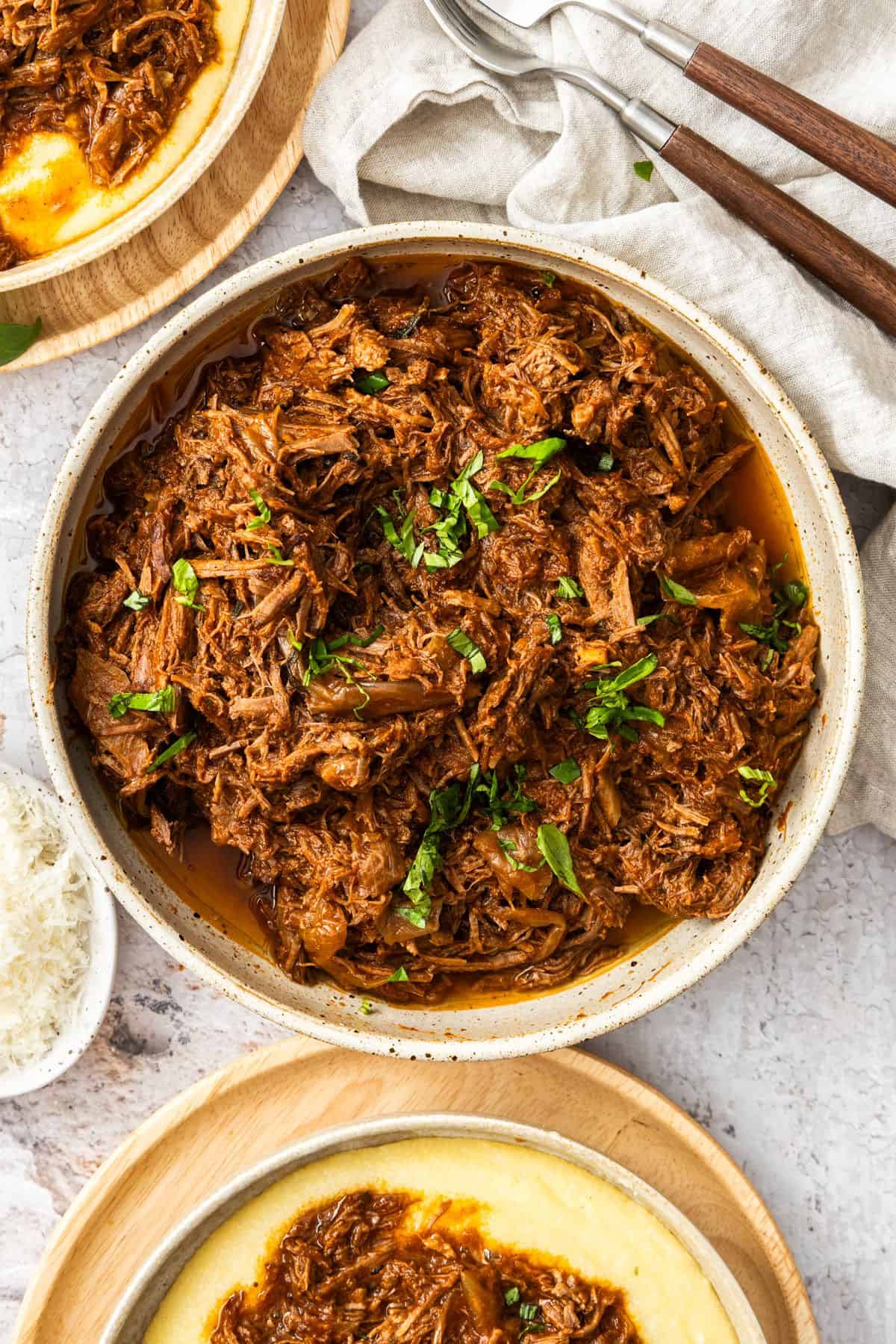
Why You'll Love This Recipe:
- If you have not previously cooked beef using this method, you will be delighted how easy it is to achieve a great result.
- The long, slow method of cooking produces succulent beef that is easily pulled apart using two forks.
- While the beef cooks, your home will fill with the tantalising aroma that promises flavoursome comfort food.
- It is a guaranteed crowd pleaser, an ideal meal for the family or perfect for easy entertaining.
- The Mediterranean flavours lend it to many serving options: your favourite pasta, creamy polenta, crusty bread and more. It is also delicious on non-Mediterranean dishes, such as nachos or as a filling for tacos.
Recipe Inspiration: I am a fan of slow cooking a less expensive cut of meat and have used this method for my Slow Roasted Pork Shoulder and Slow Roasted Leg of Lamb. This cooking method couldn't be easier, and I love that it is suitable for cooks of all skill levels. To add flavour to the beef, I use some of my favourite Mediterranean ingredients, and after spending the appropriate time in the oven, the reward is meltingly tender beef.
Ingredients and Substitutions:
Please see the recipe card further along in the post for exact quantities of ingredients and the full method.
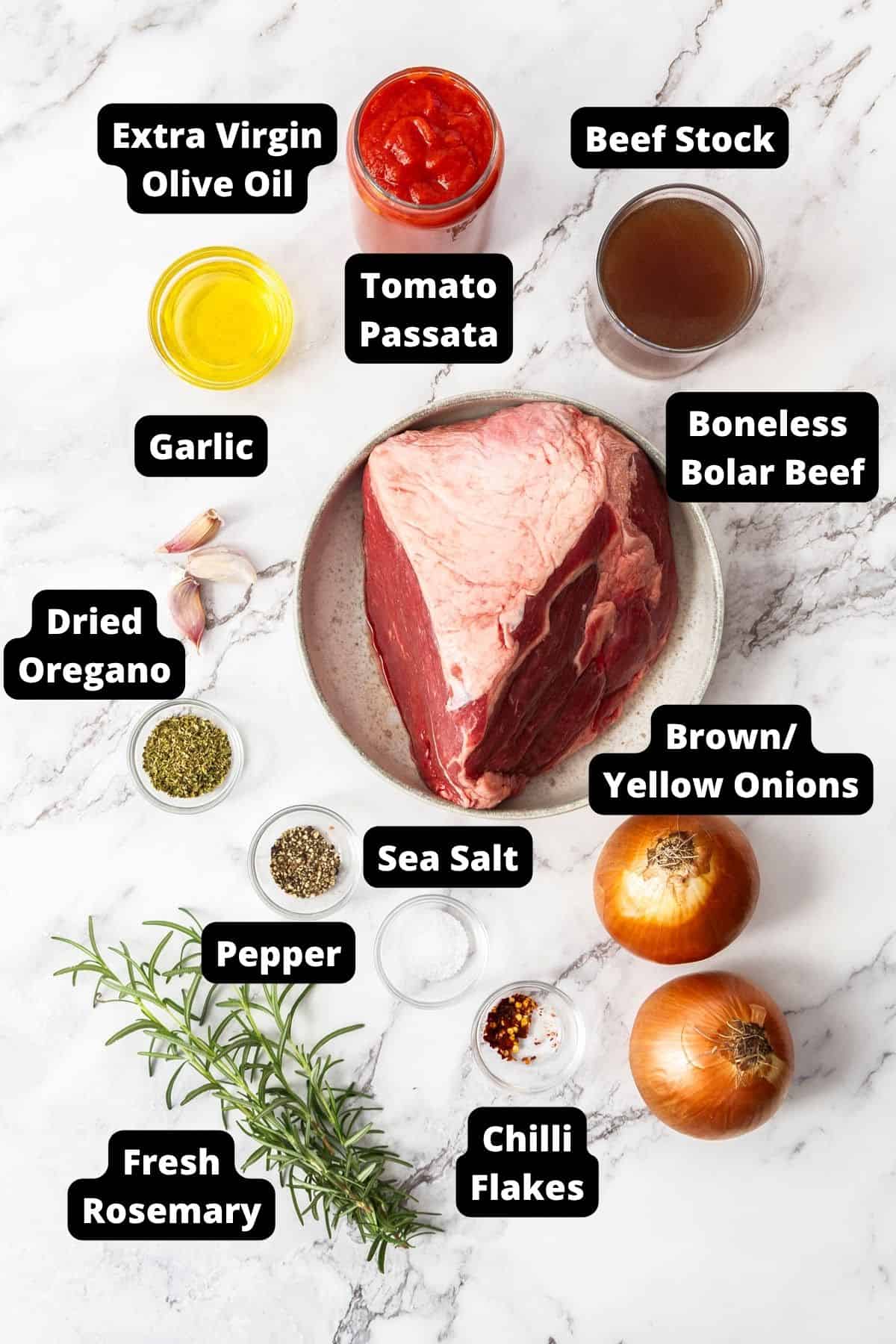
- Beef: we have tested this recipe with three different cuts, and they all work very well. My choice was the bolar roast, but all three cuts of meat lend themselves to long, slow cooking, and will produce tender, flavoursome pulled beef. However, you will get the best result with any of these cuts of meat if you use top quality, premium meat, and the best way to do this is to get to know a reliable butcher who is aware of the provenance of the meat and proud of their product. It makes a huge difference.
- Bolar roast: sometimes called a bolar blade. It is cut from the beef shoulder and is a tough cut of meat that benefits from long, slow cooking. The connective tissue and the marbled fat in this cut provide great flavour and melt-in-the-mouth shredded beef. If you are unable to source a bolar roast, we have also tested this recipe with both chuck and brisket.
- Chuck roast: may also be known as blade roast. It is from a specific part of the shoulder. This tough cut also benefits from long slow cooking that develops the flavour. It has a good amount of connective tissue and internal marbled fat and is suitable for shredding.
- Beef brisket: comes from the breast section, under the first 5 ribs. It also has marbled fat and connective tissue that makes it ideal for long, slow cooking and will produce flavoursome meat that is also suitable for shredding.
- Garlic: we use fresh garlic cloves, cut into thin slivers to insert into the meat.
- Rosemary: for additional flavour we insert fresh rosemary leaves with the garlic slivers into the beef, as well as adding some to the pan.
- Sea salt: use coarse cooking salt, not table salt.
- Freshly ground black pepper: the flavour is brighter than pre-ground black pepper.
- Extra virgin olive oil: from the first pressing of the olives, this is olive oil in its purest form.
- Brown/yellow onions: you can use white onions if you prefer.
- Dried oregano: this is one instance when I prefer to use the dried herb as it complements the flavour of the beef, rather than dominate.
- Dried chilli flakes: add gentle spice.
- Beef stock: you can use homemade stock or a good quality commercial variety. We pour the stock around the beef to keep the meat juicy and tender and add flavour.
- Tomato passata: this is pureed, strained, tomatoes, generally sold in glass bottles. If you are not able to source this, you can use the same quantity of canned, crushed tomatoes.
Variations:
Herbs: you can vary the herbs according to your preference. Fresh thyme, marjoram or bay leaves are all good options. Dried herbs are more concentrated so if you replace them with fresh herbs, you will need to use three times the amount.
Stock: you can use vegetable or chicken stock if you prefer.
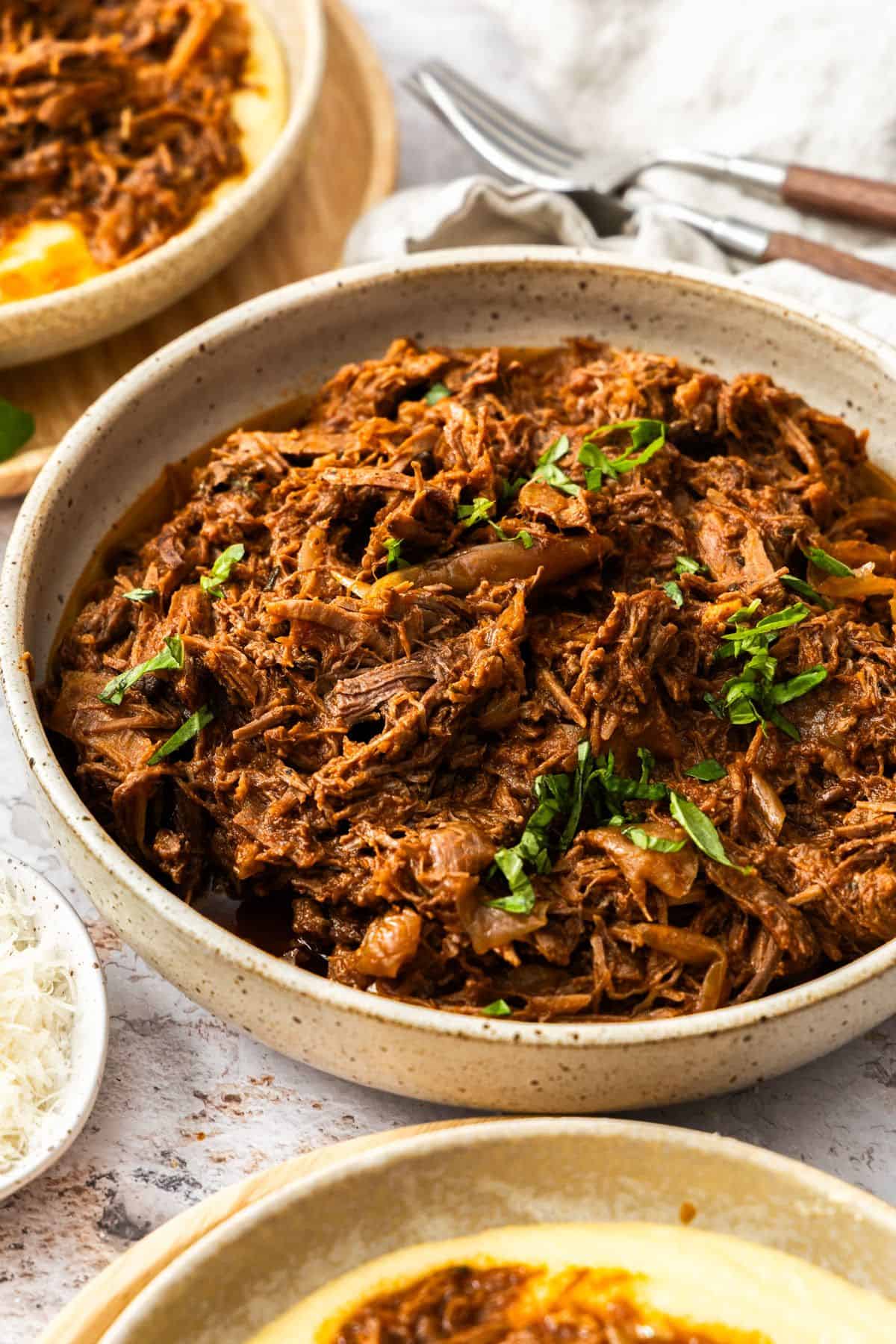
How To Make Mediterranean Pulled Beef:
Please see the recipe card further along in the post for exact quantities of ingredients and the full method.
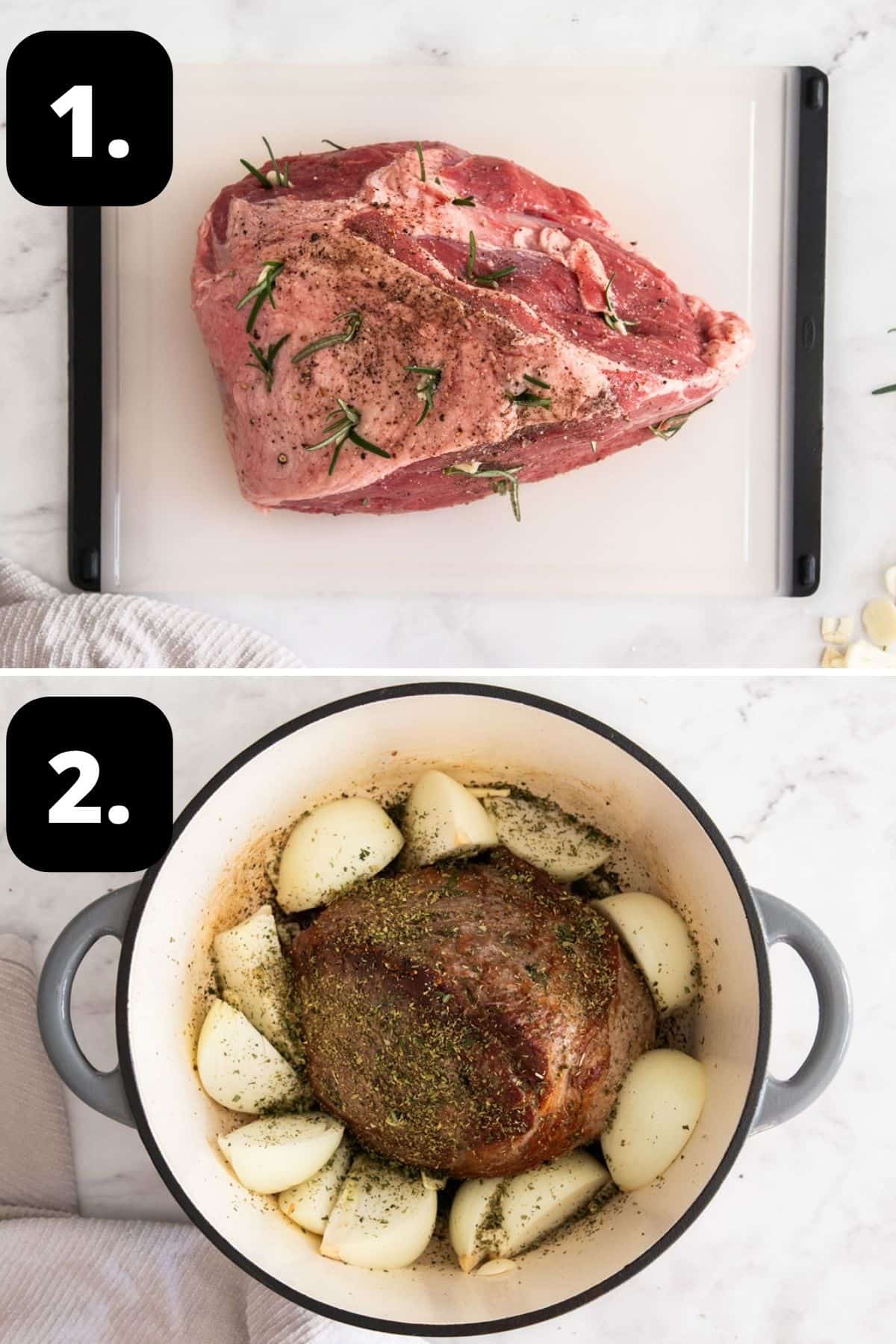
1 - Season the beef:
Using a sharp knife, make a deep insert into the flesh of the beef and insert a sprig of rosemary along with a garlic sliver. Use the tip of a blunt nose knife to push them down. Repeat this procedure on both sides. Season the beef and set aside.
2 - Brown the beef:
In a large, heavy-based Dutch oven or oven-proof saucepan with a tight-fitting lid, on your stove top, heat the olive oil on medium-high heat.
Add the beef and brown on all sides.
Remove from the heat, add the onion wedges to the saucepan and sprinkle the dried oregano and chopped rosemary on the beef. If you have any leftover garlic slivers, add them to the pan.
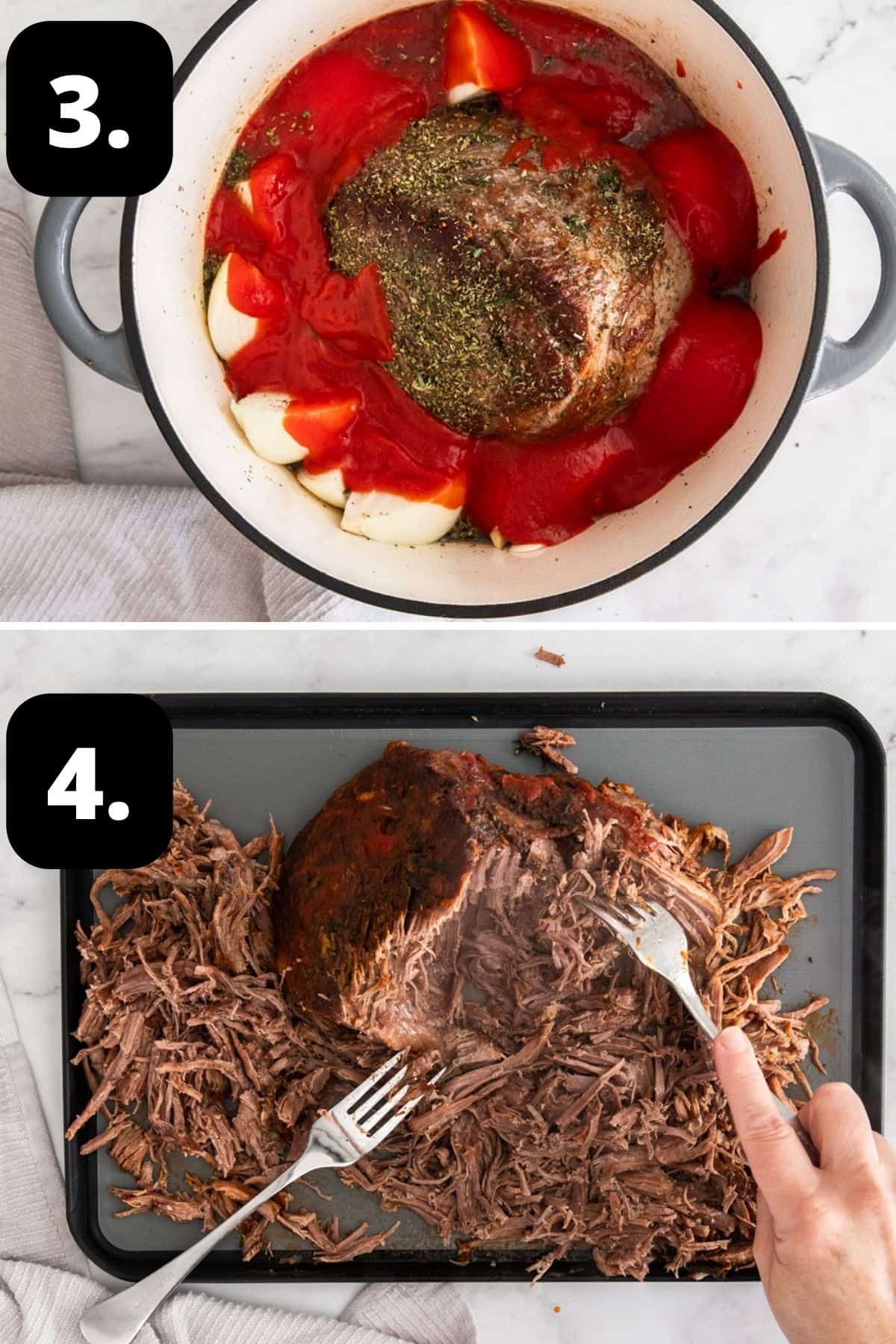
3 - Slow roast the beef:
Pour the beef stock and tomato passata around the side of the meat. Put the lid on the saucepan and place into the preheated oven.
Baste the beef with the juices throuhout the cooking process.
4 - Shred the beef:
Once cooked, carefully remove the beef from the saucepan onto a board, cover with foil and rest. Shred the beef and return to the tomato sauce.
Serve topped with finely chopped fresh basil and sides and accompaniments of your choice.
Hint: the beef will be very tender and fragile so you will need to support it when lifting it from the saucepan or it may fall apart.
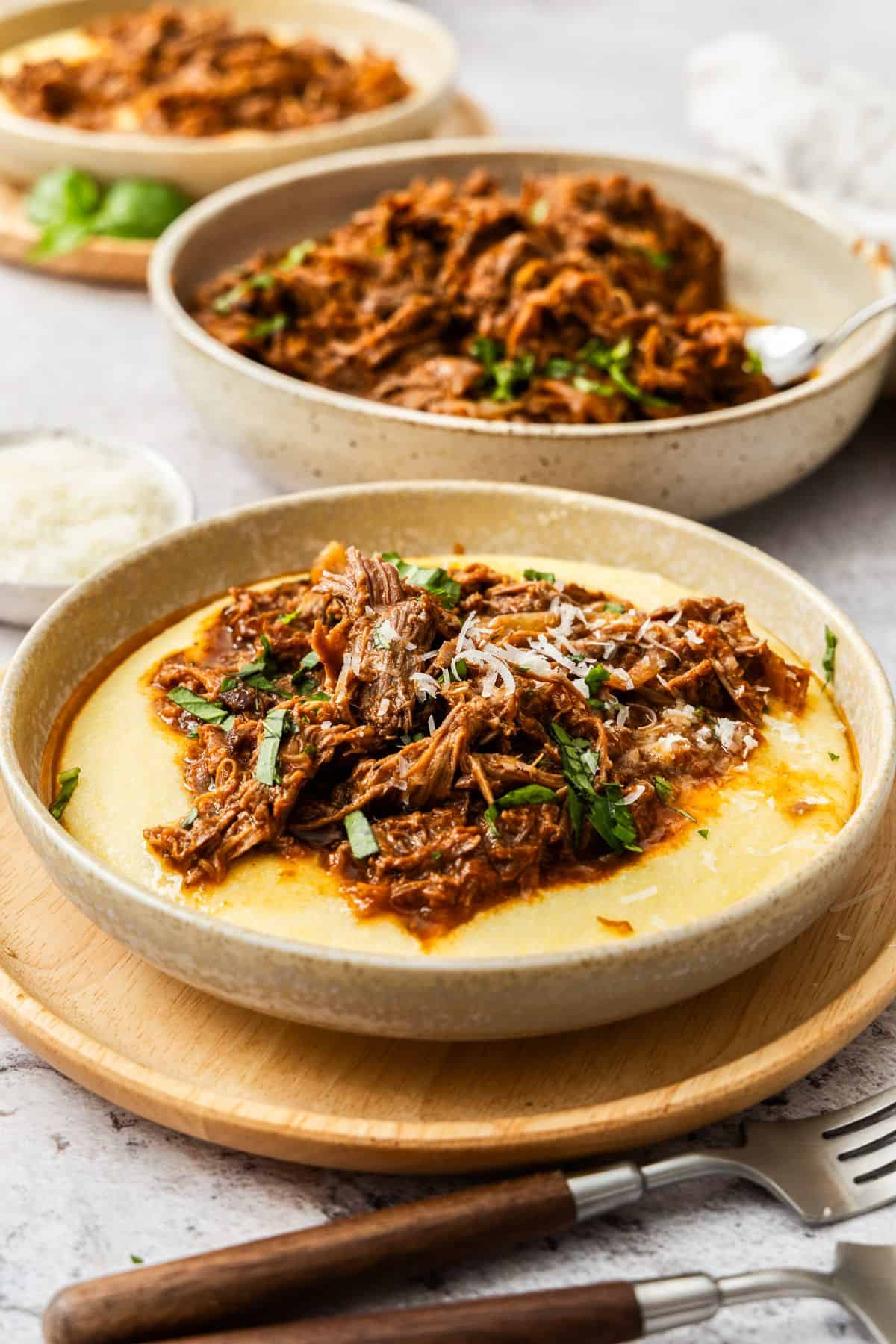
Tips for Success, Storage and FAQs:
Although it is not essential it is preferred. Browning the meat gives it a more pleasing appearance and the caramelisation that occurs adds another level of flavour. It doesn't take much time, but it is time well spent.
A well-rested piece of meat will be more tender and succulent. Resting the meat for 10-15 minutes enables the juices to redistribute throughout the meat.
Cool the leftovers as quickly as possible and store in the fridge in an airtight container for up to three days. For safety reasons, if the beef has been at room temperature for 2 hours, it should be discarded.
Yes, the leftovers freeze very well. Like my Slow Roasted Lamb Shoulder, you can freeze leftovers in a freezer-safe container for up to 2 months. Make sure the beef has cooled, then separate it into portions before storing in a freezer safe container or ziplock bag. Reheat as below.
Gently reheat in a frying pan, oven or microwave, adding some chicken stock or water if necessary to keep the flesh moist. It should be heated to register 75 degrees C (165 F) throughout.
Top Tip:
For the best result, bring the beef to room temperature before cooking. This ensures that the meat cooks more evenly.
As always, you will get the best result with good quality produce.
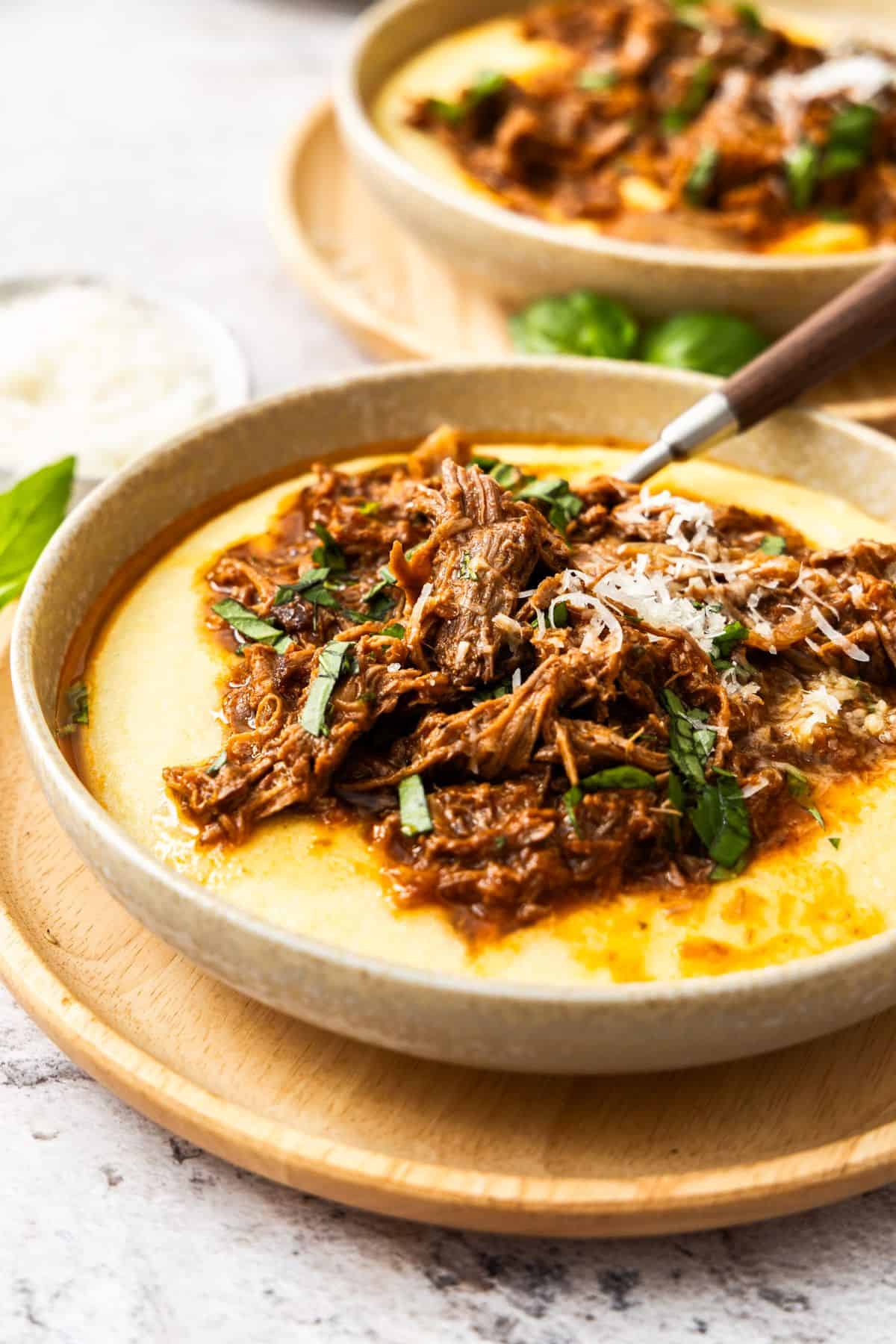
Serving Suggestions:
Our Slow Roasted Mediterranean Pulled Beef is extremely versatile. Some ways to enjoy it are:
- Alongside creamy Baked Mashed Potatoes; they complement each other perfectly.
- With our Sautéed Peppers and Onions, they add vibrant colour and Mediterranean flavours.
- In a sandwich or burger bun. Add accompaniments of your choice. I recommend that you include our Cucumber Dill Pickles or Tomato Chutney.
- With a carb such as rice, creamy polenta or pasta to soak up the flavoursome juices.
- For easy entertaining, set up a buffet with pulled beef, bread, condiments and side dishes for guests to help themselves.
- For an easy sauce, add some of our Mediterranean Red Chilli Paste to some mayonnaise. They go well together.
This very easy Mediterranean Pulled Beef is certain to become a favourite. This simple one-pot meal is satisfying and comforting. As the beef roasts, the aroma is warm and inviting, enticing everyone with the pleasure of the meal to come. I look forward to hearing if you try it.
Alex xx
More Delicious Recipes For You To Try:
Stay in touch!
Follow me on Facebook, Pinterest, Flipboard and Instagram and subscribe to my newsletter.

Mediterranean Pulled Beef
Please note:
For accuracy, when weights are provided, we recommend weighing your ingredients. This will produce the best results. All oven temperatures listed are for fan forced.
Ingredients
- 1.5 kg (3.3 lbs) boneless bolar beef/blade - trussed if necessary See Notes 1 and 2
- 3 large garlic cloves - cut into thin slivers
- 1 stalk fresh rosemary
- ½ teaspoon cooking sea salt
- ½ teaspoon freshly ground black pepper
- 2 tablespoon extra virgin olive oil See Note 3
- 2 teaspoon dried oregano
- 1 teaspoon fresh rosemary - finely chopped
- 2 large brown/yellow onions peeled and cut into thick wedges - leave some of the root end so they're secure
- 1 cup (250 ml) beef stock See Note 4
- 2 ¼ cups (560 ml) tomato passata See Note 5
- ¼ teaspoon dried red chilli pepper flakes
- fresh basil leaves - finely chopped, for serving
Instructions
- Remove the beef from the fridge. If necessary, remove excess fat and truss the meat. Using a sharp knife, make a deep insert into the fat side of the flesh and insert a sprig of rosemary (about 5 leaves) into the flesh along with a garlic sliver. Use the tip of a blunt nose knife to push them down.Repeat this procedure on all sides, leaving a space of about 2.5 cm (1 inch) between.
- Rub the salt and black pepper all over the beef and set aside at room temperature for 15 minutes.Meanwhile, preheat your oven to 140 degrees C. (285 F)After the 15 minutes, pat the beef dry with a paper towel.
- In a large, heavy-based Dutch Oven or oven-safe saucepan with a tight-fitting lid, on your stove top, heat the olive oil on medium-high heat. Add the beef, fat-side down, and brown for 3-5 minutes. Turn the meat over and continue to brown all sides for 3-5 minutes.
- Turn the heat off on the stovetop. Add the onion wedges to the saucepan and sprinkle the dried oregano and chopped rosemary on the beef.If you have any leftover garlic slivers, add them to the pan.
- Pour the beef stock and tomato passata around the side of the meat. Put the lid on the saucepan and place in the preheated oven.
- After about 1 ½ hours, carefully remove from the oven and check that there is sufficient liquid - there should be plenty. If there isn't, add a little more stock.Baste the beef with the juices and return to the oven for another 3 hours, basting again once more during the cooking process.
- Carefully remove the beef from the saucepan onto a board, cover with foil and rest for 10 minutes. (It will be very fragile - so ensure it is supported as you lift it out.)Shred the beef and return to the tomato sauce. Serve with the finely chopped fresh basil.Optional: While the meat is resting, use a ladle to remove excess fat that has risen to the surface from the pan juices.
Notes
- Boneless bolar beef: if necessary, you may need to truss the beef. We do this for two reasons; to help the meat have a more uniform shape and therefore cook more evenly. The butcher may have already trussed the meat or be happy to do it for you. But if not, it's not difficult. There are classic techniques used by butchers. They use a continuous length of twine, using specific knots, but you can get a good result with a simpler method. To begin, you will need kitchen twine. Shape the bolar blade with your hands and bring a loop of twine around, tie it as tightly as you can and cut off the ends. Repeat at 2.5 cm/1 inch intervals. It will still give you a good result.
- Other cuts of beef: brisket is also suitable. It comes from the breast section, under the first 5 ribs. Look for a cut that has good fat marbling. Chuck is also excellent. It comes from the upper shoulder, has rich flavour, a good amount of connective tissue and internal marbled fat and becomes very tender. We have found that these cuts take 30-60 minutes less cooking time, however, just check throughout the process that you're happy with the tenderness.
- Tablespoon: we use a standard Australian tablespoon which is 20 ml (4 teaspoons). For readers located elsewhere in the world, please use 1 tablespoon + 1 teaspoon for each listed tablespoon.
- Stock: it is unlikely you will need to add more liquid, but if you find it drying out when you check it, add a little more stock to the pan. We recommend using a flavoursome homemade stock or good quality commercial stock.
- Tomato passata: this is pureed, strained, tomatoes, generally sold in glass bottles. If you are not able to source this, you can use the same quantity of canned, crushed tomatoes.
- Storage: cool leftovers as quickly as possible and store in the fridge in an airtight container for up to three days. However, for safety reasons, if the beef has been at room temperature for two hours, it should be discarded.
- Freezing: freeze leftovers in a freezer-safe container for up to 2 months. Cool the beef, separate it into portions, wrap in cling wrap and store in a freezer safe container or ziplock bag.
- Reheating: gently reheat in the frying pan, oven or microwave, adding some liquid stock or water if necessary to keep the flesh moist.
- Servings: will serve 6-8 people, depending on what it is served with/how you use it. Some ideas include: on top of creamy polenta, crusty bread, your favourite pasta or as a side to a green salad and roasted vegetables.
Nutrition Estimate:
Nutritional Disclaimer:
The nutritional information is an estimate only, and is derived from online calculators. For accurate results, we recommend calculating the nutritional information based on the ingredients and brands you use.


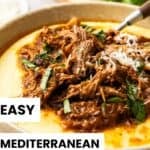




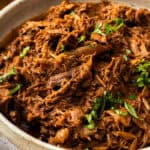


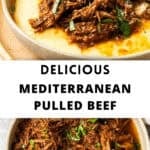
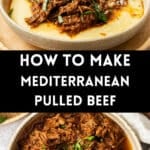
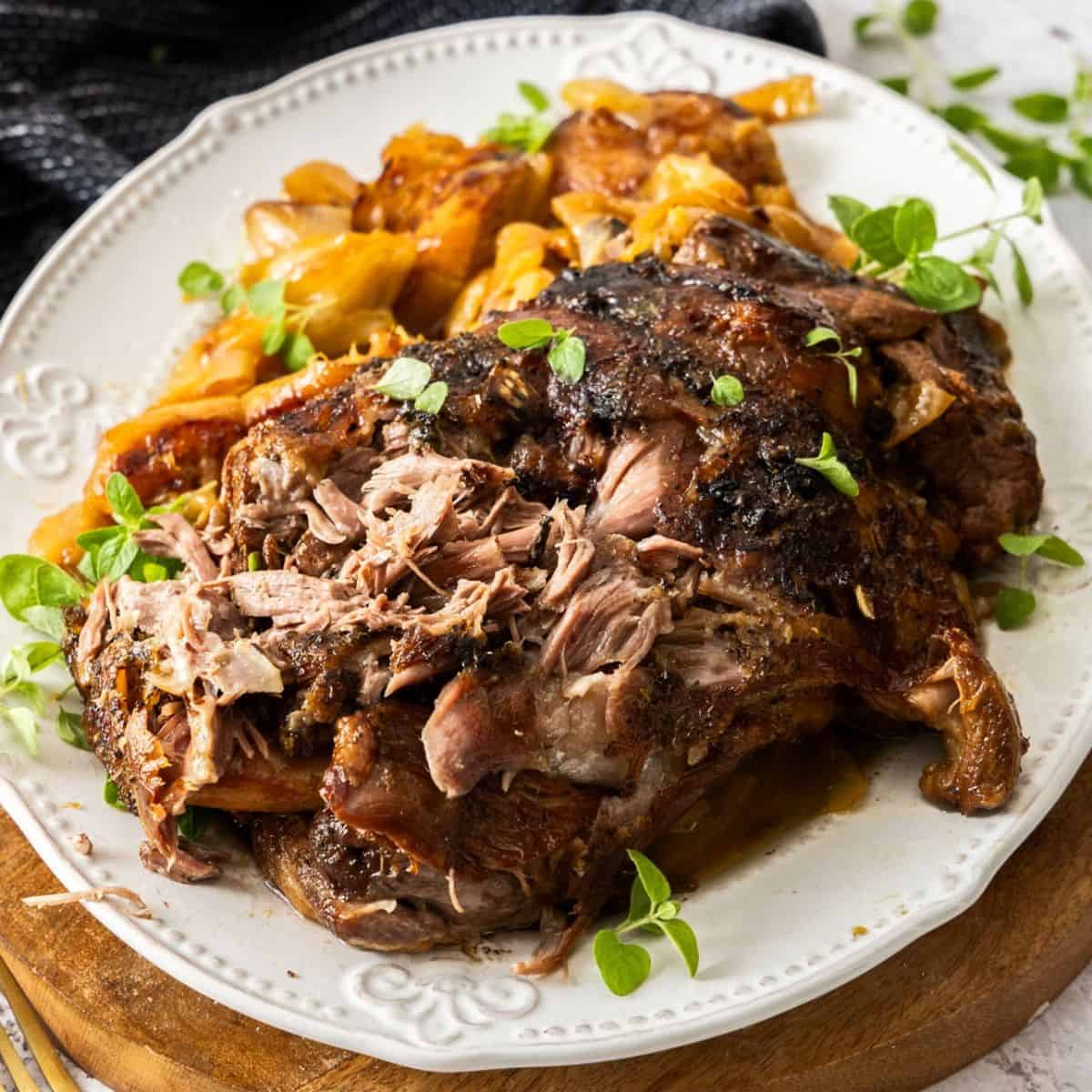
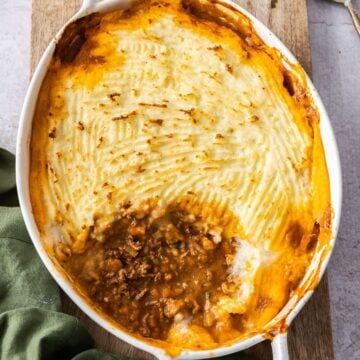
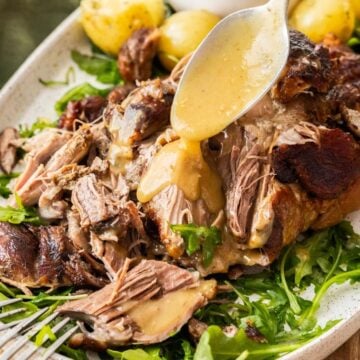
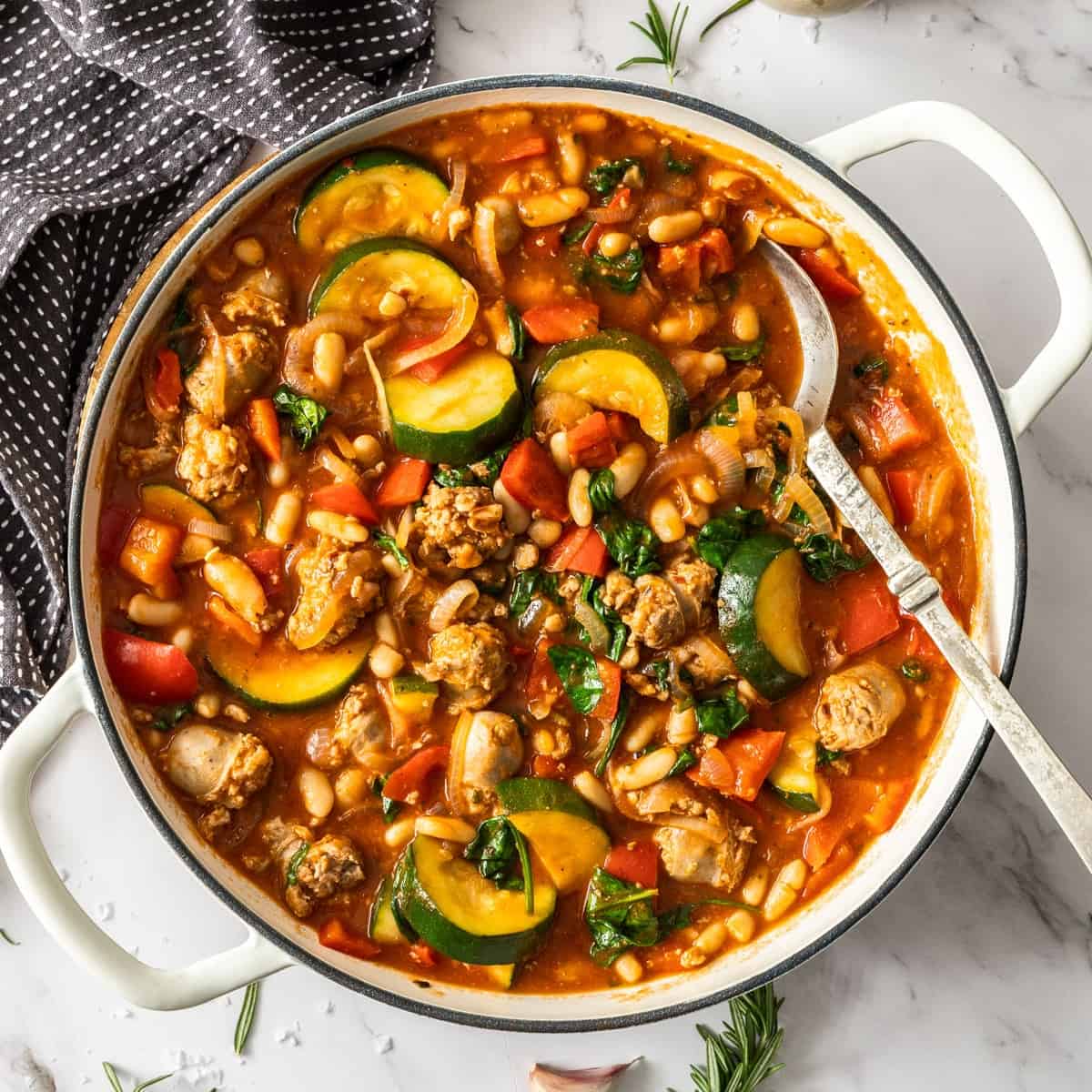

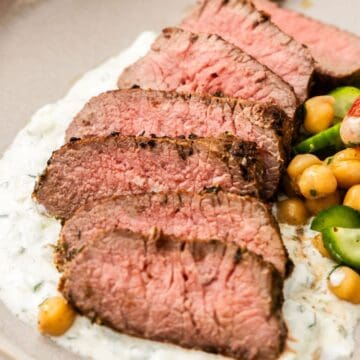

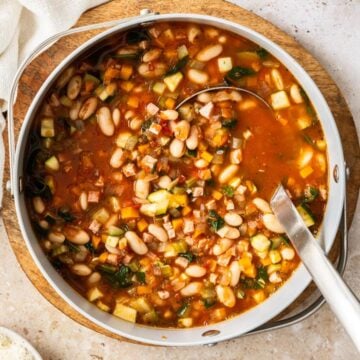
daniela says
absolutely delicious! thank you for the detailed instructions how to make this
Alexandra Cook says
Hi Daniela!
Thank you so much for making the recipe and taking the time to leave a comment.
I am so happy you enjoyed this recipe 🙂 Alex xo
Angelique says
Wonderful, flavoursome. Easy and not complicated at all!
Alexandra Cook says
Hello Angelique,
Thank you so much for making this recipe! I am so thrilled to hear you enjoyed it 🙂
Alex xo